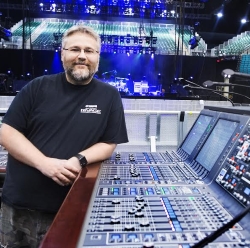
A Defined Path For Multiple Tasks
In addition to building, managing and engineering at Steve Winwood’s Cheltenham studio, James Towler also mixes front of house for the artist’s live shows.
He joined Winwood as a keyboard tech in 1997, moving to monitor engineer in 2003, and for this year’s stint on tour with Steely Dan, Towler recommended mixing monitors with a PreSonus StudioLive RM32AI rack-mount mixer for monitors and recording with Studio One 3 Professional.
“I’ve been a fan of PreSonus since 2003, when I bought the DigiMax,” he relates. “I ran monitors and did the recording feeds using 32 channels of DigiMax, with limiters, running to hard-disk recorders. So I know and like the sound of PreSonus preamps.”
When the RM32AI launched, Towler quickly acquired one, also adding the Dante option card when it was released. “For this tour, I have outboard mic preamps with Dante options, and I split the signal from there,” he explains.
“One split goes to the front of house desk and the other goes to the RM32AI, which consolidates the feeds for five monitor mixes onstage. At front of house, I have a Mac mini and an interface with a Dante card, and I take the streams into Studio One for multitracking.”
Winwood mixes his own monitors but not while playing. “We tried mixing monitors with iPads onstage but Steve was trying to jab at the iPad while playing with both hands and feet and singing,” Towler explains.
“Now he sets up his monitor mix at sound check, and I’ve got a guy onstage with an iPad to assist the musicians from there. With UC Surface, I control the RM32AI from front of house. The whole band is on in-ears, and I tweak the feeds with the RM32AI’s Fat Channel EQ and compression. Steve has them in both ears, so I put a touch of RM32AI reverb on his mix to bring it out of his head a bit.”
Evolving To New Sonic Places
Will Madera, front of house engineer for Pitbull, and Gabriel Gill, front of house engineer for Farruko, deployed Waves Audio eMotion LV1 consoles on their recent joint tour.
Madera notes, “The state of music is constantly evolving, and when the Waves eMotion LV1 mixing console burst onto the scene, there was no question in my mind that it would change the future of live sound. It’s innovative touch screen console surface and superior sound quality with incredible headroom have made it my clear choice. It’s also perfect for a true lover of plugins: the ability to use eight plugins on a channel strip is phenomenal, and it makes the LV1 a true game-changer. It was the number one choice for our U.S. tour.
Gill remarks, “I’d been looking at the eMotion LV1 mixing console in January 2016 at the NAMM convention. After a day spent in New York at a Waves seminar, I knew that would be the next board on my rider. The portability, ease of use and integrity with my Waves plugins are very important things for me. But above all, the sound quality of the board was the determining factor. Being able to integrate my Waves servers, and computers with Waves TracksLive together with the DiGiGrid IOX in such an easy way makes my setup time a lot quicker.
“With shows every day, spending less time in setup allows me to spend more time for sound check, or for Virtual Sound Check and recording the show using TracksLive,” he continues. “Also, having used Waves products in the studio for over 11 years, bringing them over to the LV1 is very beneficial. Knowing what the producers use in the studio lets me get my artist’s vocals to what the audience is used to hearing on the recording. It also lets me experiment with new sounds in the studio before I try them in a live situation.”


